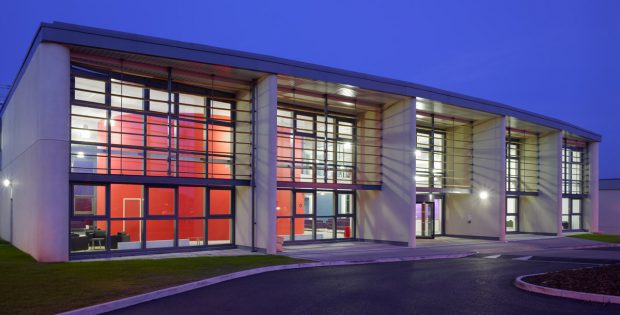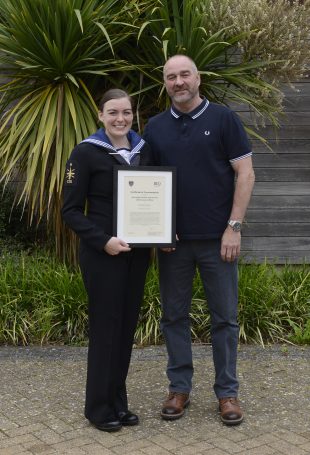Introduction by Commodore Richard Winter, Assistant Chief of Staff J3 (Operations), Defence Digital Operations Headquarters:
“When Lieutenant Commander Jon Parker joined last year, he was fresh from his Head of Department job at sea and full of enthusiasm to continue the fight for Engineer Branch rejuvenation. He wanted to exploit what he saw as a great opportunity to bring some junior talent into Defence Digital, the organisation formerly known as Information Systems and Services (ISS), and he saw Project Gunwharf as a possibility.”
Project Gunwharf success in the Defence Digital Operations Headquarters
Behind the scenes in north west Wiltshire, a substantial refocusing of what was the ISS Global Operations and Security Control Centre (GOSCC) is taking place. It’s about how information enables defence missions, with all its supporting infrastructure, and how the headquarters (HQ) will be at the front of an emerging fighting system across defence that will underpin the way the Ministry of Defence (MOD) operates in 21st century warfare.
So how does Project Gunwharf fit into this?
Gunwharf exists to better employ junior sailors when not at sea, giving them worthwhile and rewarding work between career courses. For technicians, it provides opportunities to hone their technical skills. Before Gunwharf was fully operating, in June 2018, a junior sailor, Chelcie Evans, an Engineering Technician (ET) Communications and Information Systems (CIS), moved from Portsmouth Dockyard to Corsham. Chelcie moved to help out with the assurance of capability introduction with the Release & Deployment (R&D) team in the HQ. R&D are effectively the gatekeepers to any new Information Communications Technology (ICT) service joining the Defence Digital enterprise, and so we make sure anything IT-related purchased by major organisations and Front Line Commands in the MOD is built correctly and doing the right things. It’s a small team with people from the 3 armed forces.
Historically, no-one more junior than a Chief Petty Officer (CPO) or Flight Sergeant has joined the team and it has also routinely had vacancies in some way or other as it isn’t on the Front Line. Immediately on joining, the ET’s impact was profound. Our Flight Sergeant gained capacity, allowing time to make decisions and properly consider projects coming to the R&D board without also having to manage the specialist software that supports the processes of board.
Project Gunwarf was born, with further calls to the career manning offices in Portsmouth and Plymouth dockyards bringing two additional Engineering Technicians into the HQ. These ETs worked for the Duty Operations Team and High Grade Messaging (signals or military telegrams in pre-decimalisation language) desks.

What’s it like to work in the Defence Digital Operations HQ?
There is a great contrast between the tight and disciplined world of a junior sailor working at sea or in training, and the more relaxed and professional atmosphere in Defence Digital HQ. The office brings navy, army and RAF personnel, plus civil servants and several defence contractor employees together. While the environment is top-heavy in seniority, given the strategic nature of the job and the need for highly qualified and experienced people to do it, this also makes for a less hierarchical structure, where people are valued on their technical and professional competence, not on the badges they wear.
So, what happened to the Technicians?
Each of them was fully welcomed by their receiving team and became a valued member with genuine responsibilities. All 3 had handed in their notice to leave before they joined the HQ and were marking time before becoming civilians, but 2 technicians withdrew their notice and were promoted to attend the Leading Hand CIS course (the step before progressing to the next higher rank) during their time in Corsham. The simple benefits of being treated like a professional individual, and feeling a sense of worth about their contribution, made the difference they needed.
And what of the first technician? Sometimes it is time for individuals to move into the next chapter of their life. ET Evans did leave the navy, but because of her excellent work with us and effectively doing much of what the vacant CPO’s position is there for, she received the ISS Chief Executive Officer’s commendation for exceeding her remit in assisting the R&D Board. She has since taken a job with a top telecommunications company.

Since the summer, we have formalised 6 Gunwharf positions in the Defence Digital Operations HQ, ranging from Duty Operations to Cyber Defence, and we are keen to get the contribution of new and flexible minds into what is a constantly changing and challenging workplace. Information is at the heart of defence, and this is very much the future of warfare; young talented service-people need to be in to it from the start.
Leave a comment